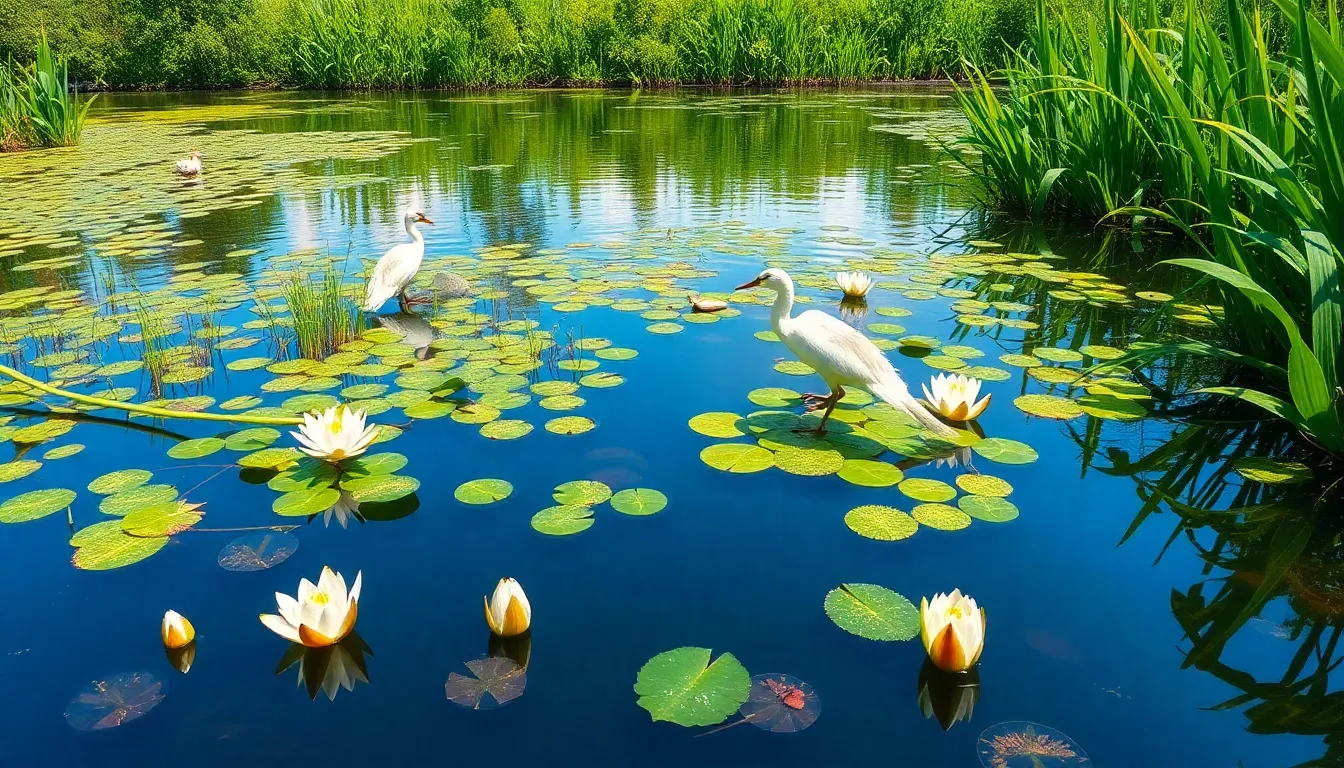Florida isn’t just famous for its sunny beaches and theme parks; it’s also home to a vibrant underwater world teeming with fascinating aquatic plants. From the lush green beds of eelgrass to the striking beauty of water lilies, these plants play a crucial role in maintaining the health of Florida’s delicate ecosystems. They’re like the unsung heroes of the waterways, providing shelter and food for countless critters while also keeping the water nice and clean.
Aquatic Plants of Florida
Florida hosts a diverse array of aquatic plants crucial for the health of its waterways. Eelgrass thrives in coastal areas, providing critical habitat for fish and other aquatic species. Water lilies dot the surface of many freshwater systems, offering shade and beauty while improving water quality.
These plants play a significant role in nutrient cycling within the ecosystem. Submerged species capture carbon dioxide, aiding in oxygen production. Emersed plants, meanwhile, help stabilize sediments and prevent erosion along shorelines.
Several other notable aquatic plants include coontail, which serves as an important food source for various wildlife, and cattails, known for their ability to filter pollutants from water. Floating plants, such as duckweed, offer shade and habitat for small organisms.
Maintaining healthy aquatic plant populations becomes vital for preserving biodiversity. They contribute significantly to the structure and function of the aquatic ecosystem. Species like hydrilla, although invasive, highlight the complexity of plant communities and their management.
As essential components of the food web, aquatic plants support fish, invertebrates, and birds. The interdependence between these plants and aquatic life enhances overall ecosystem resilience. Ensuring the health of these plants protects the rich biodiversity that defines Florida’s waters.
Types of Aquatic Plants

Aquatic plants in Florida are diverse and critical for ecosystems. They can be categorized into native and invasive species.
Native Species
Florida’s native aquatic plants include eelgrass, water lilies, and coontail. Eelgrass flourishes in coastal waters, providing habitat for fish and crustaceans. Water lilies display beautiful blooms while offering shade and improving water quality in freshwater habitats. Coontail, a submerged plant, supports oxygen levels and serves as cover for aquatic life. Cattails, often found at the edges of wetlands, play a vital role in water filtration and sediment stabilization. All these species enhance local biodiversity and contribute to the overall health of Florida’s aquatic ecosystems.
Invasive Species
Invasive aquatic plants pose significant threats to Florida’s waterways. Hydrilla, a rapidly spreading species, can choke water bodies, disrupting ecosystems and limiting sunlight for native plants. Brazilian water weed also proliferates aggressively, forming dense mats that hinder water flow and reduce oxygen levels for aquatic creatures. These invaders compete with native species for resources and hinder biodiversity. Management of invasive plants is crucial to protect Florida’s rich aquatic environments and preserve the balance within these ecosystems.
Ecological Importance
Aquatic plants play a critical role in Florida’s ecosystems. These plants offer habitat and food for various species while enhancing water quality.
Habitat and Wildlife Support
Aquatic plants provide essential habitats for numerous organisms. Fish such as juvenile snook and redfish find shelter among eelgrass beds. Additionally, water lilies serve as breeding grounds for amphibians. Birds like herons and ducks rely on these plants for foraging, while invertebrates use them as protective cover. Diverse plant species promote a balanced ecosystem, supporting both predator and prey relationships. Maintaining native vegetation helps sustain these animal populations and contributes to overall biodiversity.
Water Quality Improvement
Aquatic plants actively contribute to water quality improvement. Submerged species absorb excess nutrients, effectively reducing harmful algal blooms. By stabilizing sediments, plants like cattails prevent erosion, which helps maintain clean water. Water lilies improve oxygen levels through photosynthesis, enhancing aquatic habitat health. These plants also filter pollutants, supporting wildlife and ensuring better overall ecosystem function. Protecting and promoting native aquatic plant populations directly influences water clarity and quality in Florida’s waterways.
Cultivation and Care
Aquatic plants thrive with proper care and cultivation methods. Understanding these practices ensures a healthy ecosystem in Florida’s waterways.
Planting Techniques
Select a suitable location for planting, ensuring adequate sunlight and water depth. Use floating or anchored planters to stabilize plants like water lilies and eelgrass. Propagate native species by using seeds or seedlings, placing them in nutrient-rich soils. When planting submerged species, ensure they are spaced adequately to allow for growth. Monitor the planting site regularly to check for changes in water levels or light conditions.
Maintenance Tips
Regularly trim aquatic plants to promote healthy growth and prevent overpopulation. Remove any dead plant material to maintain water quality and clarity. Monitor for invasive species, acting quickly to eliminate them should they appear. Fertilizing at appropriate intervals encourages robust growth, especially for nutrient-loving plants. Observing the surrounding ecosystem ensures balance among native and invasive species, supporting overall health in Florida’s waters.
Conclusion
Florida’s aquatic plants play an indispensable role in maintaining the health of its diverse ecosystems. By supporting wildlife and enhancing water quality, these plants are crucial for the sustainability of the state’s waterways. The ongoing challenge of managing invasive species underscores the need for effective conservation efforts.
Promoting native species not only helps preserve biodiversity but also ensures the resilience of Florida’s aquatic environments. By understanding the importance of these plants and implementing proper care techniques, individuals can contribute to the protection and enhancement of Florida’s natural resources. The future of Florida’s waterways depends on the commitment to nurturing and maintaining its rich aquatic flora.

